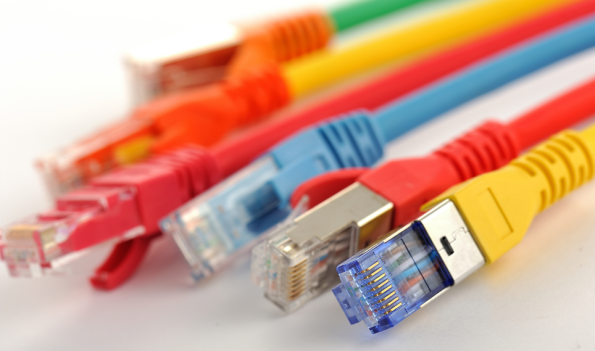In today’s network architecture, copper patch cables play an indispensable role. They are a fast and reliable connection between devices, ensuring efficient data transmission. This article delves into various types of copper patch cables, including Cat5e, Cat6, Cat6a, Cat7, and Cat8, as well as their advantages, application scenarios, and how to choose the most suitable copper patch cable.

Introduction to Copper Patch Cables
Copper patch cables are short cables used for transmitting data between network devices, typically made of copper conductors. They are widely used in homes, offices, and data centers due to their flexibility, cost-effectiveness, and efficiency.
1. Cat5e Patch Cables
Features and Advantages
Cat5e (Enhanced Category 5) patch cables are the most basic type of copper patch cables, supporting transmission speeds up to 1 Gbps. Their design reduces crosstalk, improving signal quality, suitable for short-distance connections.
Application Scenarios
Home Networks: Suitable for connecting routers with computers, printers, and other devices.
Small Offices: Provides stable connections for basic internet needs.
Selection Guide
When selecting Cat5e patch cables, pay attention to the length and shielding of the cable to ensure optimal performance.
2. Cat6 Patch Cables
Features and Advantages
Cat6 patch cables excel in transmission speed and bandwidth, supporting speeds up to 10 Gbps, suitable for more demanding network environments. Their additional isolation layer effectively reduces signal interference.
Application Scenarios
Corporate Networks: Suitable for office environments requiring high bandwidth, such as video conferencing and large file transfers.
Data Centers: Used for connections between servers and switches.
Selection Guide
When selecting Cat6 patch cables, focus on their length and certification marks, such as UL certification, to ensure compliance with performance standards.
3. Cat6a Patch Cables
Features and Advantages
Cat6a (Augmented Category 6) patch cables have been improved based on Cat6, supporting longer distances (up to 100 meters) and speeds up to 10 Gbps, suitable for high-density cabling.
Application Scenarios
Data Centers: Particularly important in environments requiring high data transmission rates, suitable for virtualization and cloud computing.
Large Enterprises: Suitable for applications requiring large data transfers.
Selection Guide
When selecting Cat6a patch cables, ensure their reliability in high-temperature or high-humidity environments and choose shielded designs to reduce interference.
4. Cat7 Patch Cables
Features and Advantages
Cat7 patch cables further increase speed and bandwidth, supporting speeds up to 10 Gbps, and adopt more advanced shielding technology to reduce external interference.
Application Scenarios
High-Performance Computing: Suitable for data-intensive applications, such as video editing and 3D modeling.
Corporate Environments: Used for connecting devices with high bandwidth requirements.
Selection Guide
When selecting Cat7 patch cables, pay attention to their material and shielding layer to ensure the best performance in high-interference environments.
5. Cat8 Patch Cables
Features and Advantages
Cat8 patch cables are currently the fastest copper patch cables on the market, supporting transmission speeds of 25-40 Gbps, suitable for future network needs.
Application Scenarios
Data Centers: Specifically designed for high-density, high-speed environments, suitable for high-frequency trading and cloud computing.
Corporate Networks: Performs excellently in application scenarios requiring extremely high bandwidth.
Selection Guide
When selecting Cat8 patch cables, ensure they are adapted to future network standards and choose cables with high-quality shielding.
Selecting the Right Copper Patch Cable
Selecting the right copper patch cable is not only about performance but also involves several factors:
- Transmission Speed: Choose the appropriate category of patch cables based on your network’s needs to ensure they can support the required speed.
- Distance: Choose the length of the patch cables based on the actual distance between devices to prevent signal attenuation from using overly long cables.
- Shielding and Materials: For environments with high noise, choose shielded patch cables to ensure stable data transmission.
- Certification Standards: Ensure that patch cables comply with industry standards, such as UL certification, to ensure their performance and reliability.
Maintenance and management of copper patch cords
- To ensure the best performance of copper patch cords, regular maintenance is necessary:
- Regular inspection: Use network test tools to detect signal quality and ensure stable connection.
- Avoid excessive bending: Pay attention to the bending angle of the cable when wiring to avoid affecting the signal.
- Proper storage: When not in use, store the patch cord in a dry, dust-free environment to prevent damage.
Conclusion
Copper patch cords play a vital role in modern networks. From Cat5e to Cat8, various types of copper patch cords are suitable for different application scenarios and meet various needs. By understanding their characteristics and application scenarios, you can choose the patch cord that best suits your network and ensure efficient and stable data transmission. Regular maintenance and reasonable management will also help you extend the life of the patch cord and make the network connection smoother.









I’m really inspired with your writing talents as well
as with the layout for your weblog. Is that this a paid topic or did you
modify it your self? Anyway keep up the nice high quality writing, it’s uncommon to see
a great weblog like this one nowadays. Instagram Auto follow!